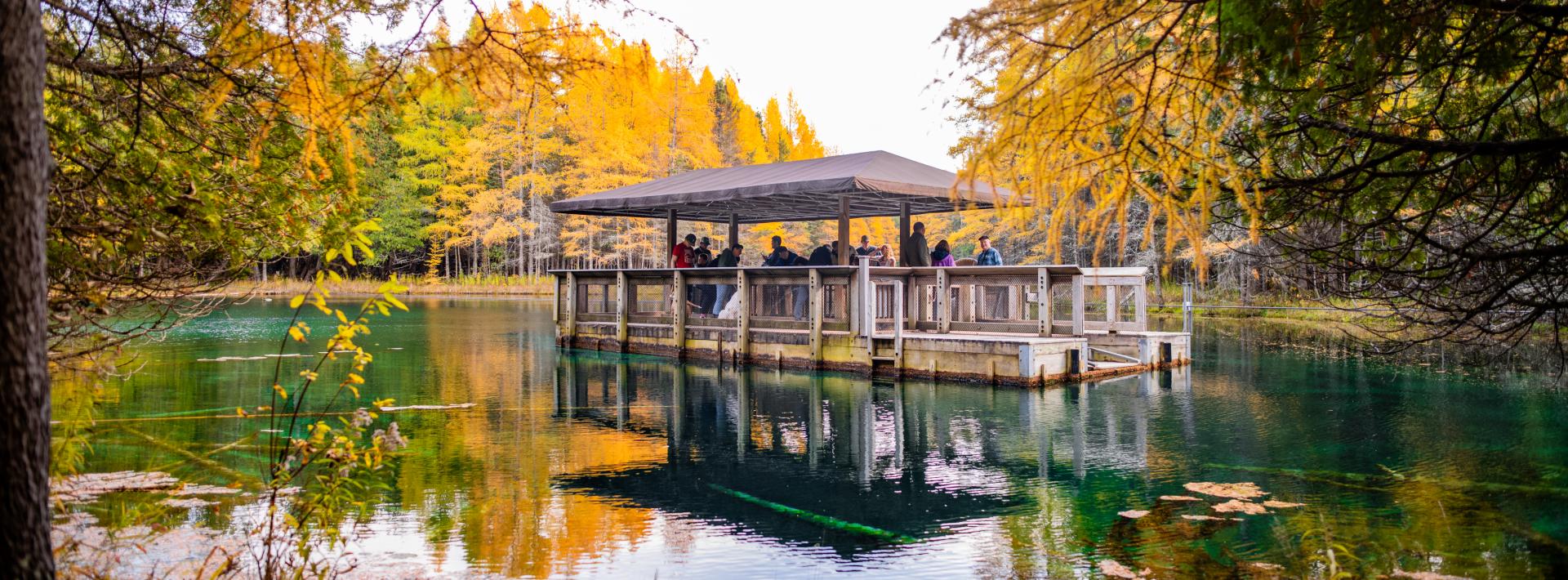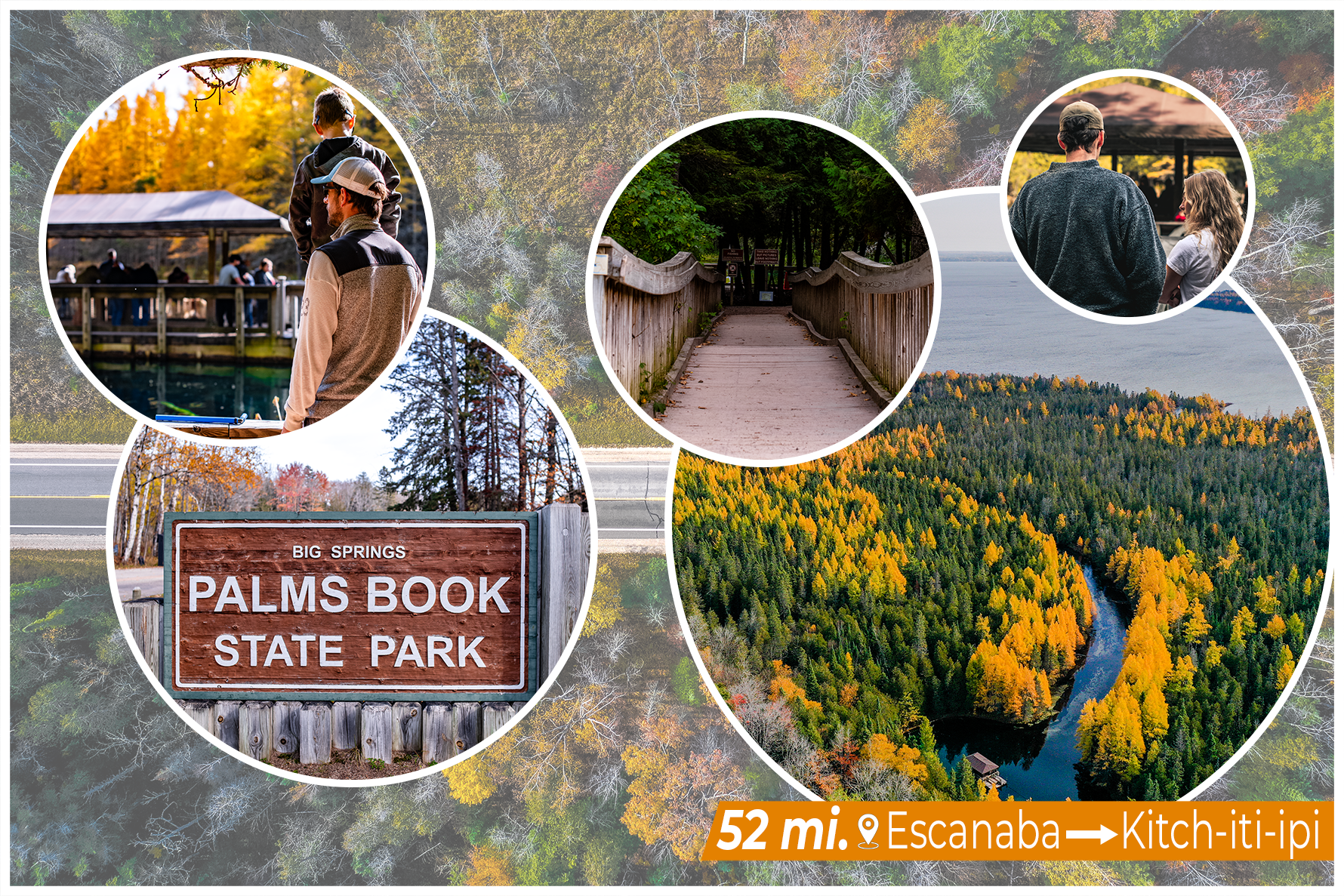
Kitch-iti-kipi - Palms Book State Park
Manistique
Manistique MI, 49854
Directions
Palms Book State Park offers an adventurous detour for those exploring the Upper Peninsula, where they'll discover one of Michigan's captivating natural wonders – Kitch-iti-kipi, or The Big Spring. Spanning 200 feet in diameter and reaching depths of 40 feet, it stands as Michigan's largest natural freshwater spring. The spring robustly emits over 10,000 gallons of water per minute from cracks in the submerged limestone, maintaining a steady temperature of 45 degrees Fahrenheit year-round. Visitors can explore these wonders aboard a self-operated floating observation raft, providing unique perspectives of the underwater world. Below the surface, ancient tree trunks, limestone-coated branches, and large trout seem to float in the clear depths. Continuously stirred by the flowing waters, clouds of sand shift and change, creating a mesmerizing display that sparks the imagination for both young and old.

Stories & Lore
According to local lore, Kitch-iti-kipi's origins are rooted in a tragic tale involving a young chief and his deceitful beloved. He told her he loved her far above the other dark-haired maidens dancing near his birch bark wigwam. "Prove it", she insisted. As a test of his devotion, she declared that he must set sail in his canoe on the pool deep in the conifer swamp. He was to catch her from his canoe as she leaped from an overhanging bough. Tragically, his canoe capsized in the frigid waters, leading to his untimely demise. Meanwhile, it turns out that the maiden was back at the village laughing at his foolish quest. The Spring was hence named Kitch-iti-kipi in remembrance of the young leader who lost his life in the cold depths, a victim of his lover's cruel whim.
Other tales recount how Chippewa parents would visit the pool to find names for their newborns. Allegedly, they discovered names such as Satu (darling), Kakushika (big eye), Natukoro (lovely flower), and We-shi (little fish) inscribed in the sounds made by the gently flowing waters. They also believed the waters possessed curative properties.
Nature's True Love
Honey & Bark
A drop of honey on a piece of birch bark dipped into Kitch-iti-kipi and presented to a loved one was to make them true forever. AThere's also a tale about the tamarack trees lining Kitch-iti-kipi's shores. It is said that after grinding a small piece of the bark ground in a mortar and pestle and placed in an individual's empty pockets would be replaced by glittering gold at exactly midnight. Whatever the legends, visitors to the spring loved them. Kitch-iti-kipi is said to have many meanings in the Chippewa language-The Great Water; The Blue Sky I See; The Roaring, Bubbling Spring. Others called it the Sound of Thunder and Drum Water, even though the quiet is eerie. Whatever its name and legend, Palms Book State Park continues to draw curious visitors.

A Park For All
Big Spring
Although it was a black hole all but hidden in a tangle of fallen trees, John I. Bellaire fell in love with the Big Spring in the early 1920s. Bellaire had come south from Seney, leaving the rip-roaring lumbering town after the white pine was gone to open a Five and Dime store in Manistique. Around the oval pool (measuring 300 feet by 175 feet) vegetation grew lush, draping over the piles of trash left by a lumber company which operated nearby. The Big Spring wasn't too different in formation from other sink holes in the area, except that it was tapped into a fast-flowing spring. Bellaire, however, saw through the debris, envisioning the beauty of the emerald bottom of the pool. He watched the sand bubble and roll as hydrostatic pressure forced water through the narrow openings at the bottom. Bellaire could have bought the property for himself, but his vision of preserving it through public ownership prevailed. In 1926 through an arrangement with Frank Book who represented the Palms Book Land Company, Bellaire arranged for the sale of almost 90 acres (including the Big Spring) to the State of Michigan for $10. Deed stipulations called for the property to be forever used as a public park, bearing the name Palms Book State Park. Additional lands through tax delinquency and land exchange eventually brought the total park acreage to 308.
The Civilian Conservation Corps and other groups eventually constructed a raft, dock, concession stand and ranger's quarters, leaving Bellaire the task of showing tourists the bubbling pool. Taking great pride in the spring, Bellaire often closed his store to personally escort interested visitors to the sacred site. In later years, Bellaire confessed to former Indian Lake State Park Manager Vic Haas that he and a poet of sorts from the Western U.P. made up the Indian legends of Big Springs themselves. He said they did it to attract visitors. Bellaire was already in his middle 70s when Haas came to Palms Book in 1948. Haas said Bellaire still visited the pool almost daily even then. The self-guided observation raft and the trail leading to it are ADA accessible.
Location:
Palms Book State Park sits at the northern end of State Highway M-149, just a 15-minute drive northward from US-2 near Thompson.




